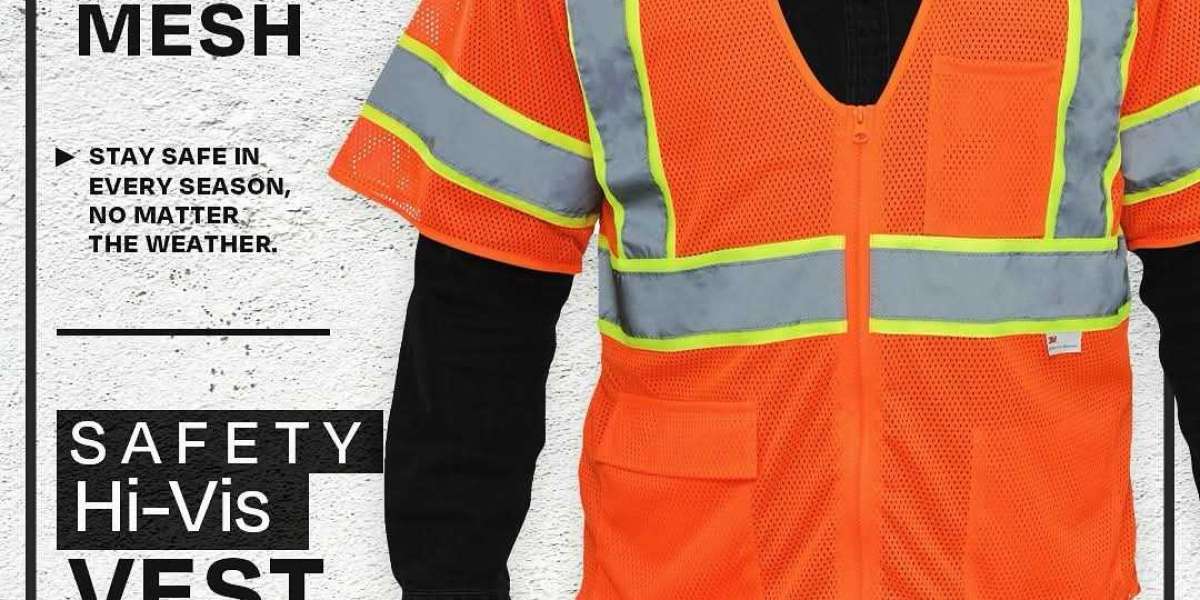Introduction: It’s Not Just About Being Seen—It’s About Staying Alive
Let’s face it—Canada isn’t your average backyard. From the coastal fog of Newfoundland to the wind-chilled plains of Saskatchewan, this country demands toughness, resilience, and gear that can keep up. Enter the high-visibility vest. Sure, it’s bright. Sure, it’s got reflective strips. But it’s also one of the simplest, most effective ways to make sure you get home at the end of a long day. Whether you’re working roadside, building high-rises, or logging trees deep in the bush, hi-vis isn’t just smart—it’s essential.
Why Every Canadian Worker Needs a Hi-Vis Vest
Working in Canada often means braving tough environments and unpredictable weather. That alone is reason enough to gear up properly. A good hi-vis safety vest ensures that whether you’re bathed in sunlight or battling a snowstorm, you're visible to vehicles, machinery operators, and fellow workers. It’s your frontline defense in a country where early sunsets and early snowfalls can sneak up on you fast. Plus, it’s not just about work—cyclists, hikers, hunters, and even dog walkers benefit from a bit of hi-vis love too.
CSA Z96: The Canadian Standard You Shouldn’t Ignore
If you’re serious about safety (and you should be), the CSA Z96 standard is your go-to guide. It tells you what qualifies as proper high-visibility gear in Canada. We’re talking specifics: the right colours (like fluorescent orange-red or yellow-green), the placement of reflective strips, and how much surface area needs to be covered to make a real impact. In short, it’s the rulebook for being seen—and it’s backed by years of data and safety science.
Breaking Down the Classes: 1, 2, and 3—What’s the Deal?
Not all vests are created equal. The CSA categorizes safety vests into three classes:
Class 1 is for low-risk areas where traffic is slow or limited.
Class 2 ups the game with more reflectivity, great for moderate-risk environments like urban road work.
Class 3 is the top tier—full-body coverage and the best choice for high-risk, low-visibility zones like highways, construction zones, and snowy wilderness.
Each class comes with different coverage requirements, so it’s not just about picking what looks the brightest—it’s about what works best for your specific job.
Cold or Hot, Rain or Shine—Vests for Every Canadian Season
Let’s be real—Canada throws everything at you. One month it’s a heatwave, the next, you’re waist-deep in snow. That’s why choosing a hi-vis vest that fits the season is crucial.
In the winter, you want insulation. Think fleece lining, wind-resistant materials, and reflective tape that doesn’t crack in the cold. In the summer, breathability becomes king. Lightweight mesh vests help regulate your body temperature while still keeping you bright as a sunrise. Waterproof and windproof features are also a big plus for anyone working outdoors during unpredictable weather—because in Canada, that’s basically every day.
From Construction Sites to Campgrounds: Where You Need Hi-Vis Most
We tend to associate safety vests with road workers and construction crews—and yeah, they definitely need them. But the usefulness of a hi-vis vest goes way beyond that. Cyclists, emergency responders, utility workers, hunters, and even outdoor festival crews can all benefit from a solid piece of visibility gear. In remote areas, a hi-vis vest can mean the difference between being spotted quickly or getting overlooked entirely in an emergency situation.
Fit and Functionality: More Than Just Flashy Colours
Let’s talk fit. A good safety vest isn’t just about reflectivity—it has to move with you, not against you. Adjustable straps, breathable materials, and multi-sized options are a must. Some vests come with extra pockets, ID windows, or radio loops, which are absolute lifesavers if you’re constantly on the go or need quick access to tools and gear.
Comfort is safety, too. If your vest rubs, rides up, or makes you sweat buckets, you’re less likely to wear it properly—or at all. Look for smart design choices that balance visibility with wearability.
Colour Counts: Why Bright Really Is Better
We’re all used to seeing that classic neon yellow or blazing orange on work sites—and there’s a good reason for it. These colours stand out against most natural and urban backgrounds. Whether it's trees, pavement, or snowbanks, the right colour makes you pop. Add in 360° reflective striping, and you’ve got visibility from all angles—even when headlights or flashlights are the only light around.
Urban, Rural, or Remote: Regional Realities for Hi-Vis Use
Canada’s vastness means your safety needs can shift dramatically from one region to another. In urban areas, you might be dealing with low-light conditions and fast-moving traffic. On the other hand, rural and northern workers need gear that holds up against freezing winds, blizzards, and long hours in isolation. In coastal provinces like B.C. or Nova Scotia, water-resistance becomes key. The bottom line? Match your vest to your environment.
Taking Care of Your Vest: Maintenance 101
Even the best safety vest won’t last forever. Reflective strips fade. Colours get dull. Fabric wears down. So here’s the rule: if your vest isn’t doing its job—if it’s no longer vibrant or reflective—replace it. Clean it regularly with gentle detergent, let it air dry, and store it somewhere clean and dry. Treat it like any other essential tool in your kit.
Smart Tech and Eco-Friendly Options Are on the Rise
Hi-vis is getting smarter. Some newer vests come with LED lighting, GPS tracking, and even heat sensors—perfect for high-risk, isolated work zones. And for the environmentally conscious? Recycled and sustainably produced hi-vis gear is becoming more available, offering safety without the carbon footprint. It’s innovation with purpose. Many wholesale suppliers in Canada offer custom solution at wholesale price.
Conclusion: Don’t Just Wear It—Depend on It
If you’re a Canadian worker—or anyone spending serious time outdoors—investing in a good safety vest isn’t just common sense. It’s a commitment to being seen, being safe, and staying ready for anything this wild and wonderful country can throw your way. Choose wisely. Wear it right. And remember, the best hi-vis vest is the one that has your back—literally and figuratively.
FAQs
1. Are hi-vis vests mandatory in all Canadian provinces?
Yes, most provinces require hi-vis vests for specific jobs, especially those involving roadside work, construction, or heavy machinery.
2. How do I know which CSA class vest I need?
Match your vest to your job risk. Class 1 for low-risk indoor jobs, Class 2 for moderate outdoor exposure, and Class 3 for high-risk, low-visibility environments.
3. Can I wear the same vest year-round?
It’s possible, but not ideal. Use breathable mesh vests in summer and insulated waterproof vests for cold, wet seasons to stay both visible and comfortable.
4. What’s the most visible colour for a vest in Canada’s snowy winters?
Blaze orange or neon yellow-green work best. They contrast well with snow and stand out against natural outdoor colours.
5. How often should I replace my safety vest?
Every 6 to 12 months for regular users—or sooner if reflective tape is fading, fabric is damaged, or colour dulls significantly.







